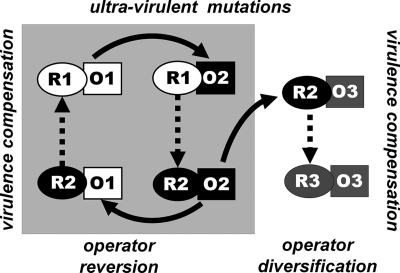FIG. 2.
Ultravirulent operator mutants drive repressor evolution and create immunity groups. An ultravirulent operator mutant (R1O2) can superinfect and replace the wild type (R1O1). In turn, repressor mutants that compensate virulence (R2O2) are resistant to the ultravirulent-strain (R1O2) and invade. This process creates the two immunity groups R1O1 and R2O2. Now the operator O2 of immunity group R2O2 can either revert to R2O1 (which is ultravirulent with respect to R1O1) or form new operator alleles (e.g., O3). Resistance to the new operator allele O3 can be achieved by mutation to a matching repressor, R3. Origin and compensation of new operator alleles ultimately generate the diversity of immunity groups.

